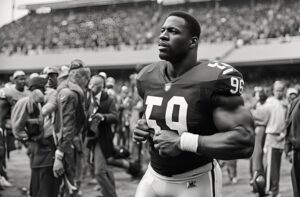
In 2025, a landmark decision by the World Federation of Sports (WFS) shook the world. The approval of steroids in all professional sports was viewed by some as the end of true sportsmanship, while others celebrated it as the dawn of a new, exhilarating era. This significant change was driven by years of covert misuse, rampant corruption, and relentless calls for evenhanded competition. The passing of this legislation was met with a mix of anticipation and concern globally, as sports prepared for deep and unfathomable transformations.

Initially, the change was greeted with both joy and apprehension. Athletes, who had previously used steroids covertly, were now able to drive their physical capabilities to greater heights without any inhibition. This lead to a succession of new world records. The 2028 Tokyo Olympics showcased feats of superhuman prowess. Previously unimaginable weights were lifted, sprinters raced like cheetahs, and gymnasts achieved remarkable flexibility; all due to the chemical enhancements now embraced. Public interest rose sharply, ticket sales and television ratings surged to record highs.
However, beneath this facade of triumph and glory, a more unsettling reality began to unfold. Athletes became commodities, owned by corporations who viewed them as a goldmine of marketable skill. Training routines became unimaginably grueling, descending into realms of near torture. Potent concoctions of steroids were developed and administered by specialized scientists, intent on pushing the human body to the extreme. These intense physical demands began to have unforeseen effects on the athletes’ health. By the 2030s, sports medicine had changed profoundly, merging elements of athletic training and emergency medical care.
The public’s opinion started to shift as the long-term implications of widespread steroid use became apparent. Reports of athletes facing severe health complications, both physically and mentally, began to emerge. The instances of cardiovascular diseases, liver damage, and psychological disorders became ominously frequent. Youth started to lose their desire to emulate their sports idols. Participation in school sports programs declined as parents feared the cost of achieving excellence had become dangerously high.
The political arena could not overlook the growing dissatisfaction. Movements fronted by former athletes, who had retired prematurely due to the harmful effects of steroids, began to take shape. They presented a bleak picture of the future if the issue wasn’t addressed urgently. The WFS, the body that had legalized steroids, faced intense pressure to reevaluate their decision. The debate divided society. One side defended the spectacle and advancement steroids brought, while others demanded a return to a natural and unenhanced form of competition.

By 2040, the crisis reached a crucial point. Although medical improvements had enhanced many lives, they lagged behind the escalating physical pressures on athletes. Steroid-induced ailments resulted in premature deaths of several renowned sports stars, shocking the global audience. Sports spectacles had transformed into grim reality shows, with audiences dreading inevitable health crises as much as they hailed new records.
In this chaotic environment, a new generation of athletes, pledging to compete without chemical aids, surfaced. Initially dismissed and dismissed within the professional field, they gradually gained prominence. Their message of authenticity, resilience, and genuine sportsmanship resonated with a public weary of the excesses and tragedies prevalent in the sports world. Simultaneously, grassroots movements advocating for a return to natural competition and stricter regulations on artificial enhancements gained momentum.
In reaction to the outcry, the WFS was compelled to respond. In a pivotal 2045 meeting, a decree was passed ending the era of legalized steroids. The shift was monumental and fraught with hurdles, but it signified the start of a transformative chapter. Athletes, now released from the pressure to enhance their abilities artificially, centered their efforts on refining their natural talents, thus heralding a renaissance in sportsmanship.




